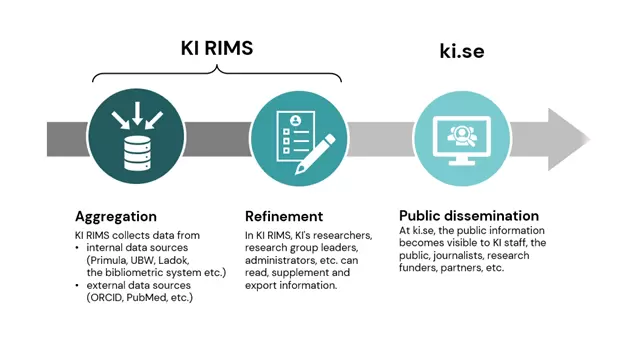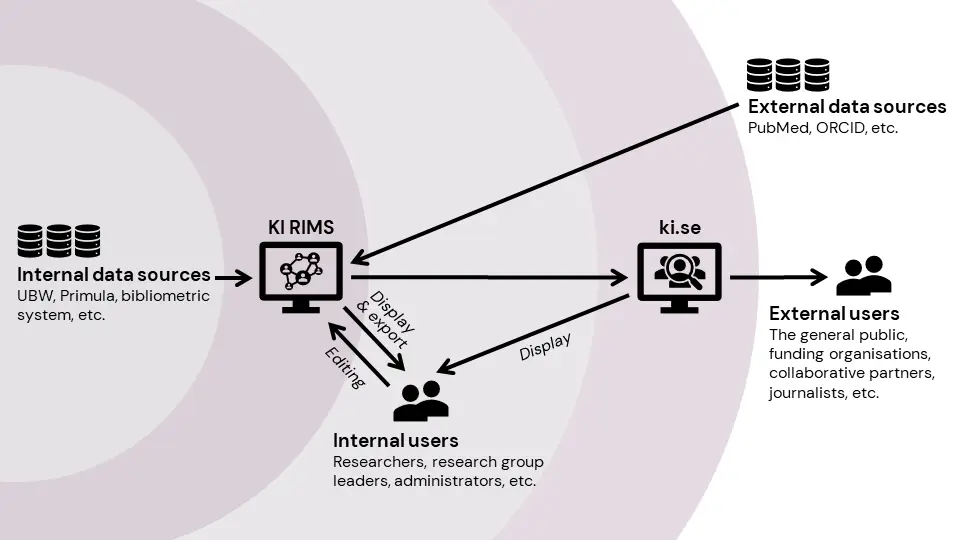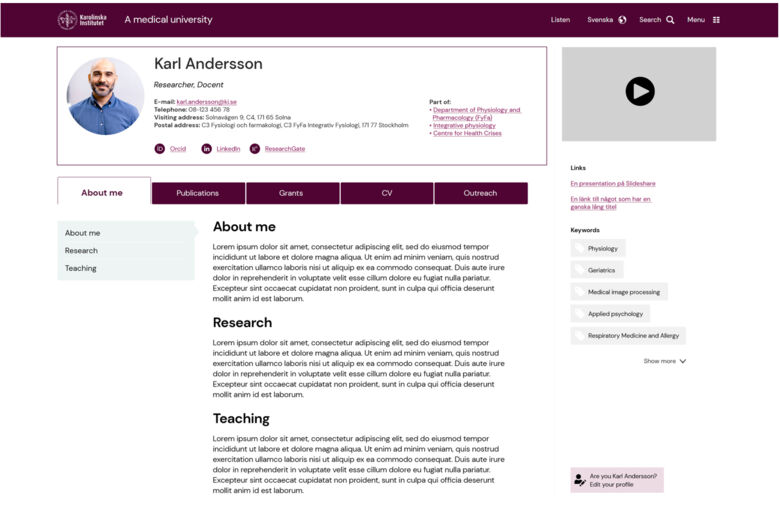About KI RIMS
Here is an introduction to KI RIMS, KI's research information system. You will find information about the functions of the system, the data sources on which the information is based, and the possible areas of use of the system.
What is KI RIMS?
A Research Information Management System (RIMS) is a system that manages research information, and its purpose is to collect, improve and make the information about the university's research available. The system that KI has chosen is called Symplectic Elements and it is a software service offered by the UK-based company called Symplectic which is part of the company Digital Science.
KI RIMS gathers data on publications and research grants. Researchers can then use the compiled information to, for example, generate their CV and publication list. KI RIMS has three main functions - aggregation, refinement and public dissemination.

How does KI RIMS work?
Much of the data in KI RIMS is retrieved automatically from other systems within the university which makes it easier for researchers at KI to keep information about their own and their group's research and publications up to date. It is also possible to enter and update information manually.
Some information, such as publication lists and group members, is also retrieved from KI RIMS to personal profile pages and group pages on ki.se.
Data sources for KI RIMS
KI RIMS retrieves information from several different data sources within KI:
- From IDAC name, phone number and e-mail address is collected.
- From Primula / UBW Anknutna employments are collected.
- From Primula docent degree at KI is collected.
- From Ladok degrees from KI are collected.
- From the Bibliometric system scientific publications and people's research area and current USV-unit is collected.
- From KI Open Archive theses are collected.
KI RIMS also contains large amounts of information from several external data sources that either show up as suggestions for publications or research grants under Pending or enrich already claimed items with both richer and more types of metadata:
- Bibliometric parameters (that are shown in some of the reports) can be collected from: Web of Science, Dimensions and Europe PMC.
- External research grants can be collected from: Dimensions
- Publications can be collected from: PubMed, Europe PubMed Central, Web of Science, Dimensions, Crossref and others.
KI RIMS depends on the data quality in other systems and the systems’ possibility to data integration. At present, it is not possible to integrate everything on the wish list, but development is ongoing.
The illustration below show how the information is managed and displayed:

What is the difference between the Bibliometric system and KI RIMS
| Bibliometric system | KI RIMS |
|---|---|
| Higher data quality | High, but not infallible data quality |
| Used for publication analyses and resource allocation | Used for making research information visible and reusable |
| Only publications from PubMed and WoS from 1995 | More publication types from more sources and the possibility to add publications manually |
Even if much of the information in the bibliometric system is transferred to KI RIMS, the bibliometric system will continue to be used for resource allocation and publication analysis for the foreseeable future. It is therefore still important to verify all your publications in the bibliometrics system.
TIP: Make it a habit to always verify your publications in the bibliometric system before adding any information about your publications in KI RIMS.
Which information from KI RIMS is shown on ki.se?
Profile page
On ki.se there are so-called profile pages for all employees. The profile page contains your contact information and can also be expanded with more information about your background, what you work with, assignments, publications and more.
You can in most cases control which information will be displayed on your profile page on ki.se by switching between the visibility levels Public and Internal in KI RIMS.

Pages for research groups
All research groups will have their own group page in KI RIMS. It will be shown on ki.se and can be enriched and published there by a web editor. Some information is retrieved from KI RIMS and some information is added by the web editor.
On the web publishing pages, you can read more about the new group pages.

Filtering research information
The filtering function, under development, searches and filters information on both groups and individual researchers. The filtering uses the labels you put on yourself and your publications and grants. It is therefore important that you have labels that describe yourself.
Areas of use
Here are examples of use cases where KI RIMS can be useful:
- As a researcher, you can easily extract a list of publications to use in your CV or qualifications portfolio.
- As a researcher, you can supplement and add information about yourself and your research in addition to the automatically generated information to increase visibility and findability.
- As the coordinator of a network or centre, you can use keywords to describe your research, making it easier for others to find the right research area.
- As a Dean, Head of Department, or Research Coordinator, you can explore what research exists at KI's departments to promote collaboration.
- As a Research Group Leader, you can find out who at KI is doing research in areas related to your own in order to propose collaborations.
- As a PI, you get an easily maintained website that allows others to find information about the group's members, research, publications, ongoing and completed projects.
- As a scientific leader, you can get an overview of the research within your group to help you plan your activities.
- As a journalist, administrator or decision-maker, you can find an expert in a certain research field at KI to get material for your work.
Purpose and objectives
The purpose of KI RIMS is to create a coherent systems support for research information at KI, so that adequate, up-to-date and accurate information about KI’s ongoing and completed research and researchers will be easily accessible to both external and internal users. Among other things, this means that:
- It should be easy to find up-to-date and relevant information about KI researchers and ongoing or completed KI research, both internally and externally.
- KI researchers should be able to achieve increased dissemination of information about their research without increased administration.
- There should be overviews of KI’s ongoing and completed research, presented in a way that is both relevant and pedagogical.
- It should be faster to obtain relevant decision/analysis bases related to KI’s research and researchers.
